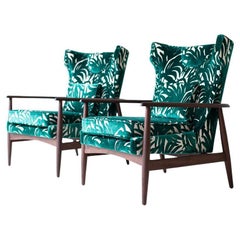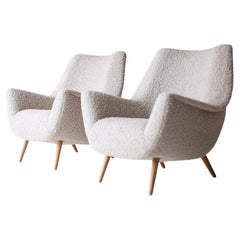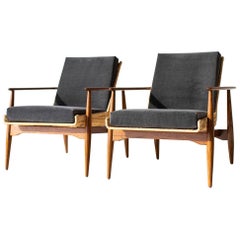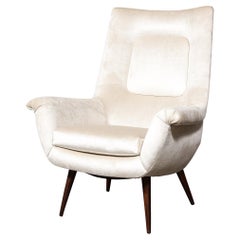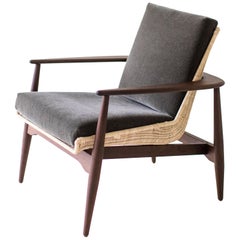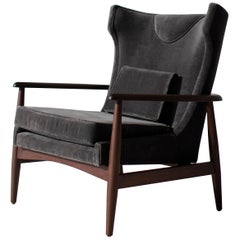Lawrence Peabody Lounge Chairs
American designer Lawrence Peabody imbued his mid-century modern furniture with flair and style. His vintage lounge chairs, side tables and credenzas feature sleek silhouettes and chic curves. At the same time, every piece has an easy and comfortable appeal reflective of a designer known to be humble and pragmatic.
Peabody was born in 1924 in Haverhill, Massachusetts. As a young man, the story goes, he joined the Navy partly because he found the uniforms aesthetically appealing. After World War II, Peabody used the benefits offered by the G.I. Bill to attend the Rhode Island School of Design. There, he studied under Austrian designer Ernst Lichtblau, who introduced Peabody to the Bauhaus style.
After completing his studies in America, Peabody moved to Denmark and attended the Royal Danish Academy of Fine Arts. Here, he met his wife, Bette, who he married in 1952. By 1955, Peabody had moved back to America and settled in Boston, where he created Danish-inspired seating for the Selig furniture company and opened a design firm called Lawrence Peabody & Associates.
One of the firm's earliest designs was a walnut and rattan cradle chair for Richardson Nemschoff, which earned the 1962 International Design Award. Peabody became known for using walnut in his work and drew on Scandinavian modernist influences in his designs.
For the next three decades, Lawrence Peabody & Associates developed an extensive client list that included names like Kohler, Richardson Brothers, Chapman Lamps and Boyd Lighting.
Throughout his life and career, Peabody also developed a love of Haiti and Haitian art. On one trip to Port-Au-Prince, he met and befriended a man named Dewitt Peters, founder of Le Centre d'art, a haven for local artists. Peabody and Dewitt collaborated to promote handcrafted Haitian art and furniture at overseas museums. Peabody even became one of the organization's directors. He eventually purchased a home in Port-Au-Prince and spent much time there later in life.
Today, Craft Associates Furniture holds the license to produce Peabody designs.
On 1stDibs, find vintage Lawrence Peabody seating, tables, storage cabinets and other furniture.
2010s American Mid-Century Modern Lawrence Peabody Lounge Chairs
Fabric, Wood, Walnut
2010s American Mid-Century Modern Lawrence Peabody Lounge Chairs
Wood, Bouclé, Oak
2010s North American Mid-Century Modern Lawrence Peabody Lounge Chairs
Teak
1960s American Mid-Century Modern Vintage Lawrence Peabody Lounge Chairs
Velvet
2010s American Modern Lawrence Peabody Lounge Chairs
Wicker, Walnut
2010s American Modern Lawrence Peabody Lounge Chairs
Velvet, Walnut
1950s American Mid-Century Modern Vintage Lawrence Peabody Lounge Chairs
Bouclé, Walnut
1970s American Mid-Century Modern Vintage Lawrence Peabody Lounge Chairs
Cane, Walnut
2010s American Modern Lawrence Peabody Lounge Chairs
Wood, Walnut
1950s Danish Mid-Century Modern Vintage Lawrence Peabody Lounge Chairs
Bouclé, Beech
20th Century American Mid-Century Modern Lawrence Peabody Lounge Chairs
Upholstery, Walnut
20th Century American Modern Lawrence Peabody Lounge Chairs
Wicker, Walnut
2010s North American Mid-Century Modern Lawrence Peabody Lounge Chairs
Walnut
1970s American Mid-Century Modern Vintage Lawrence Peabody Lounge Chairs
Cane, Wood
1960s American Mid-Century Modern Vintage Lawrence Peabody Lounge Chairs
Chenille, Walnut
1960s Danish Scandinavian Modern Vintage Lawrence Peabody Lounge Chairs
Leather, Upholstery, Beech
Mid-20th Century American Mid-Century Modern Lawrence Peabody Lounge Chairs
Wicker, Wood
2010s American Modern Lawrence Peabody Lounge Chairs
Leather, Cane, Wood, Walnut
1950s American Mid-Century Modern Vintage Lawrence Peabody Lounge Chairs
Maple
2010s American Modern Lawrence Peabody Lounge Chairs
Fabric, Teak
2010s American Mid-Century Modern Lawrence Peabody Lounge Chairs
Velvet, Ziricote
1960s American Mid-Century Modern Vintage Lawrence Peabody Lounge Chairs
Naugahyde
2010s American Modern Lawrence Peabody Lounge Chairs
Leather, Walnut
2010s American Modern Lawrence Peabody Lounge Chairs
Leather, Walnut
2010s American Modern Lawrence Peabody Lounge Chairs
Fabric, Walnut
Mid-20th Century American Mid-Century Modern Lawrence Peabody Lounge Chairs
Wool, Walnut
1950s American Mid-Century Modern Vintage Lawrence Peabody Lounge Chairs
Iron
20th Century American Mid-Century Modern Lawrence Peabody Lounge Chairs
Velvet
1970s American Mid-Century Modern Vintage Lawrence Peabody Lounge Chairs
Upholstery, Walnut
1970s American Mid-Century Modern Vintage Lawrence Peabody Lounge Chairs
Upholstery, Wood
Mid-20th Century American Mid-Century Modern Lawrence Peabody Lounge Chairs
Wood
1960s American Mid-Century Modern Vintage Lawrence Peabody Lounge Chairs
Upholstery, Walnut
1950s American Mid-Century Modern Vintage Lawrence Peabody Lounge Chairs
Upholstery, Wood
1960s American Mid-Century Modern Vintage Lawrence Peabody Lounge Chairs
Fabric
1960s American Mid-Century Modern Vintage Lawrence Peabody Lounge Chairs
1950s American Mid-Century Modern Vintage Lawrence Peabody Lounge Chairs
Wood, Oak
1960s American Mid-Century Modern Vintage Lawrence Peabody Lounge Chairs
Upholstery, Walnut
2010s American Modern Lawrence Peabody Lounge Chairs
Leather, Walnut
1970s American Mid-Century Modern Vintage Lawrence Peabody Lounge Chairs
Walnut
2010s American Modern Lawrence Peabody Lounge Chairs
Leather, Wood, Walnut
1970s American Mid-Century Modern Vintage Lawrence Peabody Lounge Chairs
Upholstery, Wood
Mid-20th Century American Mid-Century Modern Lawrence Peabody Lounge Chairs
Upholstery
2010s American Mid-Century Modern Lawrence Peabody Lounge Chairs
Walnut
2010s American Mid-Century Modern Lawrence Peabody Lounge Chairs
Fabric, Walnut
